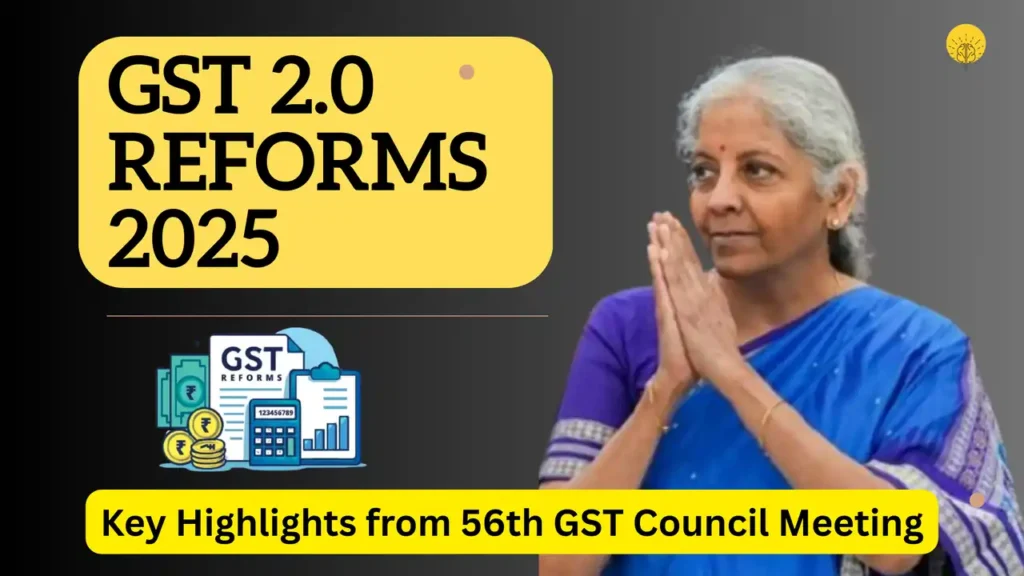New Delhi: In a transformative move set to reshape India’s taxation landscape, the Goods and Services Tax (GST) Council has rolled out the ambitious GST 2.0 reforms, simplifying the tax structure and delivering significant relief to millions of consumers. Announced on September 4, 2025, and effective from September 22, 2025—the first day of Navratri—these reforms aim to ease the financial burden on the common man, bolster key economic sectors, and streamline compliance.

A Simplified Two-Rate GST Structure
The 56th GST Council meeting, held in New Delhi on September 4, 2025, under the leadership of Union Finance Minister Nirmala Sitharaman, marked a historic overhaul of India’s GST framework. The council, a constitutional body established under Article 279A via the 101st Constitutional Amendment Act, 2016, and chaired by the Union Finance Minister, includes representatives from states and Union Territories. The meeting saw participation from Union Minister of State for Finance Pankaj Chaudhary, Chief Ministers of Delhi, Goa, Haryana, Jammu and Kashmir, Meghalaya, and Odisha, Deputy Chief Ministers of Arunachal Pradesh, Bihar, Madhya Pradesh, and Telangana, the Governor of Manipur, and Finance Ministers from various states.
The council’s key decision was to rationalize the GST structure into a two-rate system: a 5% merit rate for essential goods and services and an 18% standard rate for most other items. The previous 12% and 28% slabs have been eliminated, effective September 22, 2025, except for tobacco products, which will transition later upon notification. A special 40% rate has been introduced for sin goods and luxury items, replacing the compensation cess to maintain revenue neutrality.
Prime Minister Narendra Modi, who flagged these reforms during his Independence Day speech, described them as a “Diwali gift” for citizens, emphasizing their role in simplifying taxation and boosting economic growth. The council’s objective remains to set tax rates, formulate policies, and provide recommendations to the central and state governments, ensuring a transparent and predictable GST regime.
New GST Rates 2025: What’s Getting Cheaper?
The GST 2.0 reforms prioritize affordability, particularly for daily essentials, healthcare, education, and mobility. Effective September 22, 2025, the following changes will take effect:
- Zero GST: Ultra-high temperature (UHT) milk, chena, paneer, all Indian breads (chapati, paratha), and 33 life-saving drugs, including three for cancer, rare diseases, and severe chronic conditions, are now GST-exempt, down from 5% or 12%. All individual life insurance policies (term life, ULIP, endowment), health insurance policies (family floater, senior citizens), and reinsurance also attract zero GST, making insurance more accessible and aligning with the goal of “insurance for all” by 2047.
- 5% Merit Rate: A wide range of daily essentials now fall under the 5% slab, reduced from 12% or 18%. These include:
- Personal Care: Hair oil, toilet soap, soap bars, shampoos, toothbrushes, toothpaste, tooth powder, face powder, talcum powder.
- Household Items: Tableware, kitchenware, utensils, sewing machines, feeding bottles, umbrellas, bamboo furniture, combs.
- Food and Beverages: Namkeen, bhujia, sauces, pasta, instant noodles, chocolates, coffee, preserved meat, cornflakes, butter, ghee, condensed milk, cheese, figs, dates, avocados, citrus fruits, sausages, meat, sugar boiled confectionery, jam, fruit jellies, tender coconut water, fruit pulp or juice, milk-based beverages, ice cream, pastry, biscuits, cereals, sugar confectionery, packaged roti, dry nuts, instant coffee (down from 18%).
- Agriculture and Mobility: Farm tools, agricultural machinery (down from 12%), bicycles.
- Services: Salons, gyms, barbers, yoga centers (down from 18%, without input tax credit).
- Healthcare: Several drugs and medicines reduced from 12% to 5%.
- 18% Standard Rate: Items previously taxed at 28% now fall under 18%, including:
- Automotive: Small cars and motorcycles up to 350 cc, buses, trucks, ambulances, three-wheelers, and all auto parts at a uniform 18%.
- Consumer Durables: Air-conditioning machines, televisions (all types, including above 32 inches), dishwashing machines.
- Infrastructure: Cement and renewable energy devices.
- Textiles: Corrections to inverted duty structures in manmade fiber, yarn, and cotton sectors; garments above ₹2,500 at 18% (up from a 5% limit at ₹1,000).
Education items like maps, charts, globes, and pencils also see reduced rates, enhancing affordability for students.
The 40% Special Rate: Targeting Sin Goods and Luxuries
To curb harmful consumption and maintain revenue, a 40% special rate replaces the compensation cess on sin goods and luxury items. This includes:
- Tobacco Products: Pan masala, gutkha, cigarettes, chewing tobacco (zarda), unmanufactured tobacco, bidi, scented tobacco, cigars, cheroots, cigarillos.
- Beverages: Sugary and flavored drinks, carbonated caffeinated drinks, energy drinks.
- Luxury Vehicles: Cars over 1200cc petrol or 1500cc diesel, SUVs, yachts, helicopters.
- Miscellaneous: Imported dutiable personal-use articles and select luxury transport goods (details pending notification).
Tobacco products will remain at current GST + cess rates (50-55% effective) until cess loans are discharged, then shift to 40%. Non-economy air travel seats rise from 12% to 18%, and labour charges increase from 12% to 18%, prompting concerns from airlines and small entrepreneurs. Vegetable oil producers continue to demand resolution of inverted duty structures on edible oils.
Institutional Reforms and Simplified Compliance
The GST Council has introduced measures to streamline compliance and reduce litigation:
- Goods and Services Tax Appellate Tribunal (GSTAT): Operational by September 2025 for appeals, with hearings by December, ensuring faster dispute resolution.
- Credit Note Disputes: The requirement for prior agreements on post-sale discounts is removed, with clarifications expected on input tax credit (ITC) for commercial credit notes, secondary discounts, and promotional activities.
- IGST Settlement: Tamil Nadu’s push for implementing the Committee of Officers’ report on Integrated GST settlement by December 2025 was approved, enhancing efficiency.
- Digital Push: E-invoicing, digital reconciliations, and automated filings promote a cashless, paperless economy, benefiting sectors like IT and consulting.
The Central Board of Indirect Taxes and Customs (CBIC) is confident of upgrading backend technology by September 22, ensuring a smooth transition, as stated by Chairman Sanjay Kumar Agarwal.
Industry Reactions: Widespread Support with Some Concerns
The reforms have elicited widespread praise, though some sectors raised concerns:
- Healthcare: Apollo HealthCo’s Shobana Kamineni called zero GST on insurance a “masterstroke” for accessible care. Insurers like LIC’s R Doraiswamy and Hinduja Group’s Ashok P Hinduja see it as revolutionary for penetration by 2047.
- Automotive: SIAM’s Shailesh Chandra and FADA’s C.S. Vigneshwar hailed the 18% rate on vehicles, benefiting first-time buyers and boosting demand. Mahindra’s Anish Shah praised inclusivity, though clarification on cess balances is sought. IATA’s Sheldon Hee criticized the 18% rate on premium air travel.
- FMCG and Retail: Coffee leaders Rajat Agarwal (Barista) and Rana George (Kelachandra) welcomed instant coffee’s drop to 5%, predicting higher consumption. Bata India’s “Bata Price Promise” absorbs 7% on footwear below ₹1,000 early, per MD Gunjan Shah.
- Cement: CMA’s Neeraj Akhoury and Adani’s Vinod Bahety expect infrastructure acceleration with cement at 18%.
- Textiles: The Cloth Manufacturers Association of India (CMAI) praised revisions but urged removing the 18% rate on garments above ₹2,500.
- Others: Nasscom sees tech export boosts; PRADAN’s Saroj Kumar Mahapatra notes agri relief; Teamlease’s Rishi Agrawal highlights innovation scope.
Union Ministers Piyush Goyal, Ashwini Vaishnaw, and Bhupender Yadav lauded the reforms for boosting consumption, ease of business, and clean-energy transitions. Mukesh Ambani promised Reliance would pass on savings, calling it a consumption booster. Industrialist Harsh Goenka termed it a “big Diwali gift.”
The Biju Janata Dal (BJD) demanded full GST exemptions on kendu leaves and handloom, plus ₹1,000 monthly compensation for Odisha’s revenue loss.
Political Responses: Mixed Reactions
Prime Minister Modi hailed GST 2.0 as a “double dose of support and growth,” adding “five new gems” to India’s economy, benefiting the poor, middle class, women, students, farmers, and youth. He emphasized cooperative federalism for a developed India by 2047.
Rajasthan CM Bhajanlal Sharma called it historic, UP CM Yogi Adityanath saw it as a step toward self-reliance, and Goa CM Pramod Sawant termed it an “early Diwali gift.” Congress’ P. Chidambaram noted the government’s realization of past mistakes, while Pawan Khera credited Rahul Gandhi’s 18% cap advocacy, criticizing delays. Congress labeled it “GST 1.5,” with Jairam Ramesh highlighting unaddressed state compensation demands. Karnataka’s G. Parameshwara welcomed reductions but urged further cuts.
Economic and Market Impact
Stock markets rallied: the BSE Sensex rose 150.30 points (0.19%) to 80,718.01, after peaking at 81,456.67; NSE Nifty gained 19.25 points (0.08%) to 24,734.30. FMCG stocks like Britannia (7.18%) and Dabur (6.14%), durables like Blue Star (4.57%), cement stocks like Orient (2.97%), and auto stocks like Maruti hit 11-month highs. Tobacco stocks surged despite the 40% rate, as overall tax burdens remain stable at 88% for cigarettes, per ITC.
Morgan Stanley projects a 0.2-0.3% GDP boost in FY26, with 20-30 bps lower CPI inflation. Bank of Baroda’s Sonal Badhan expects revenue to be offset by higher consumption, limiting fiscal deficit risks. SBI Research predicts 65-75 bps inflation moderation. The net fiscal impact is ₹48,000 crore (0.13% GDP), balancing ₹93,000 crore foregone with ₹45,000 crore gains.
Broader Implications: Cheaper Homes and Strategic Context
Reductions in cement and steel GST are expected to lower input costs, boosting affordable housing and infrastructure, per real estate leaders. The reforms counter new US tariffs (50% on Indian goods, effective August 27, 2025) by spurring domestic consumption.
FAQs
1. What are the new GST rates introduced in the GST 2.0 reforms, and when do they take effect?
The GST 2.0 reforms, announced on September 4, 2025, during the 56th GST Council meeting, simplify the tax structure into two main slabs: a 5% merit rate for essentials and an 18% standard rate for most goods and services. The previous 12% and 28% slabs have been eliminated. A special 40% rate applies to sin goods and luxury items like tobacco, aerated drinks, and high-end cars. These changes take effect from September 22, 2025, except for tobacco products, which will transition later upon notification.
2. Which items will become cheaper under the new GST rates?
Starting September 22, 2025, numerous daily essentials will see reduced GST rates:
18% GST: Small cars, motorcycles up to 350 cc, TVs, air conditioners, dishwashers, cement, buses, trucks, and auto parts, previously taxed at 28%. Education items like maps and pencils, and medical devices also become more affordable.
Zero GST: UHT milk, paneer, chapati, paratha, all Indian breads, 33 life-saving drugs, and all individual life and health insurance policies.
5% GST: Hair oil, soap, shampoos, toothpaste, bicycles, farm tools, agricultural machinery, namkeen, coffee, butter, ghee, and services like salons, gyms, and yoga centers.
3. What are sin goods, and why are they taxed at 40%?
Sin goods, taxed at the new 40% special rate, include harmful or socially costly items like tobacco products (cigarettes, gutkha, pan masala), sugary and carbonated drinks, and luxury goods like high-end cars (over 1200cc petrol or 1500cc diesel), SUVs, yachts, and helicopters. The higher rate, replacing the compensation cess, aims to discourage consumption while maintaining revenue neutrality. The government expects stable revenue due to the inelastic demand for these goods, with funds supporting welfare programs.
4. How will the GST 2.0 reforms impact consumers and businesses?
Consumers benefit from lower prices on essentials, healthcare, and insurance, boosting affordability and consumption, especially for low-income households. Businesses gain from simplified compliance, with the operationalization of the GST Appellate Tribunal (GSTAT) by September 2025, eased credit note disputes, and digital filing advancements. Sectors like automotive, FMCG, cement, and healthcare see growth potential, though airlines and small entrepreneurs face challenges from higher rates on premium air travel and labour charges.
5. What is the economic impact of the GST reforms, and how do they address global challenges?
The reforms are projected to boost India’s GDP by 0.2-0.3% in FY26, per Morgan Stanley and Bank of Baroda, with retail inflation potentially dropping by 65-75 basis points, per SBI Research. The net fiscal impact is ₹48,000 crore (0.13% GDP), balancing revenue foregone with gains from the 40% slab. These changes counter new US tariffs (50% on Indian goods, effective August 27, 2025) by spurring domestic demand, supporting India’s economic resilience and growth trajectory.

